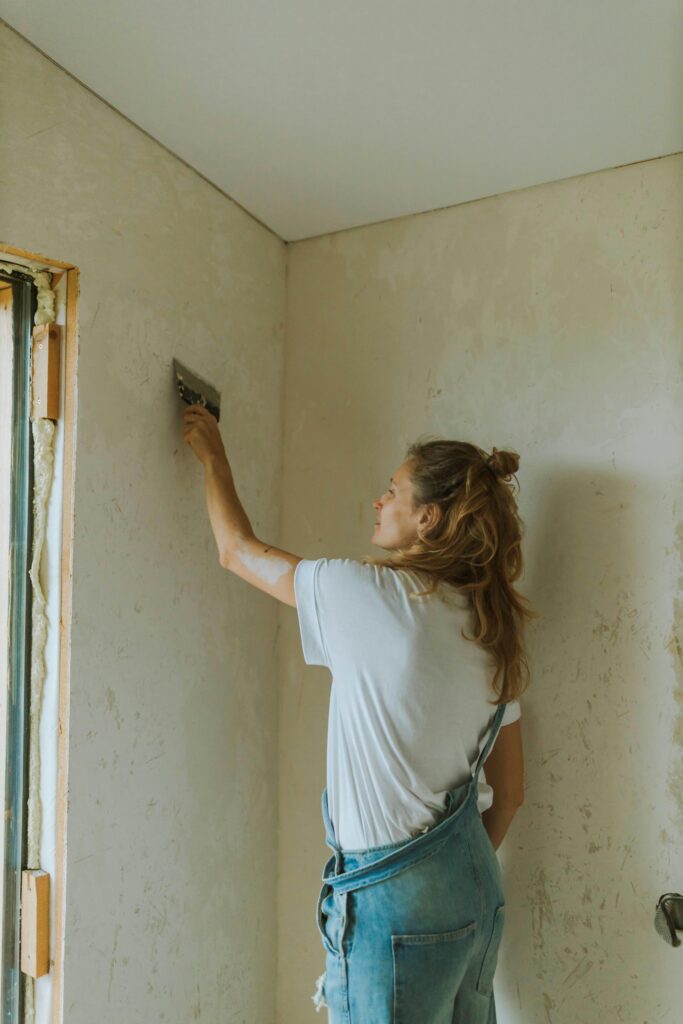Painting on wet plaster can make or break your walls – let’s explore the professional techniques and crucial timing that ensure flawless results. As experienced specialists in Bromley and Kent, we’ve seen countless DIY disasters from homeowners rushing to paint freshly plastered walls. This comprehensive guide will reveal everything you need to know about achieving perfect results.
Understanding Wet Plaster and Paint Compatibility
Fresh plaster undergoes a complex chemical process as it dries and cures. When newly applied, plaster contains significant moisture content – typically around 40% water content. This moisture must evaporate properly to create a stable surface for painting. Modern plasters used in the UK generally consist of gypsum-based compounds that require specific conditions to cure correctly. The drying process involves both evaporation of surface moisture and deeper chemical changes that can take several weeks to complete fully.
The Chemistry of Fresh Plaster
During the curing process, calcium hydroxide in the plaster reacts with carbon dioxide from the air to form calcium carbonate, creating a strong, stable surface. This chemical reaction, known as carbonation, is crucial for developing the plaster’s final strength and durability. The process typically takes 2-5 weeks in standard UK climate conditions, though factors like humidity, temperature, and ventilation can significantly impact drying times.
Why Traditional Fresco Techniques Differ from Modern Painting
- Fresco painting utilises specific lime-based plasters designed for immediate painting
- Modern gypsum plasters require complete drying before paint application
- Historical techniques rely on mineral pigments that bond chemically with wet plaster
- Contemporary paints form a surface film that needs a stable, dry substrate
- Traditional frescos become part of the wall structure; modern paints create a separate layer
The Risks of Painting Too Soon
Applying paint before plaster has fully dried can lead to numerous serious problems that are both costly and time-consuming to rectify. Professional decorators in Kent regularly encounter issues caused by premature painting, with 75% of early paint failures linked to insufficient drying time. The most common problems include peeling, bubbling, and uneven colour absorption.
Paint Adhesion Issues
- Paint can peel or flake due to poor surface bonding
- Bubbles may form as moisture tries to escape
- Patchy or uneven colour absorption
- Surface efflorescence causing white, powdery deposits
- Complete paint failure requiring full removal and reapplication
Moisture Trapped Behind Paint
When paint creates a seal over damp plaster, it traps moisture within the wall. This can lead to serious long-term problems including mould growth, deteriorating plaster, and compromised wall integrity. In severe cases, the trapped moisture can even affect adjacent building materials and structural elements.
The Perfect Timing for Painting Plaster
Professional decorators recommend waiting at least 3-4 weeks before applying any paint to newly plastered walls. However, this timeline can vary based on several factors including room temperature, ventilation, and humidity levels. In the UK’s often damp climate, longer drying times may be necessary, particularly during winter months.
Determining When Plaster is Ready
- Visual check: Plaster should be uniformly light in colour with no dark patches
- Touch test: Surface should feel completely dry and not cool to touch
- Moisture meter reading should be below 12%
- No visible condensation on windows in the room
- Surface should be free from any efflorescence
The Critical First Coat: Mist Coating Explained
The mist coat is crucial for successful paint adhesion on new plaster. Mix good quality emulsion paint with water in a 70:30 ratio (paint:water) for optimal results. This diluted first coat allows proper penetration into the plaster surface, creating a stable foundation for subsequent paint layers.
Professional Techniques for Perfect Results
Achieving a professional finish requires more than just waiting for the right time to paint. The choice of materials, preparation techniques, and application methods all play crucial roles in the final result. Professional decorators in Bromley and Kent consistently achieve superior results by following specific procedures and using high-quality materials.
Choosing the Right Paint Products
- Use breathable emulsion paints for the mist coat
- Select premium vinyl matt or silk finishes for topcoats
- Avoid using cheap builder’s emulsion
- Consider specialist plaster sealers for challenging conditions
- Use appropriate primers for specific paint types
Application Methods and Tools
Professional application techniques focus on achieving even coverage and perfect finish. Use high-quality synthetic brushes for cutting in and professional-grade rollers with the appropriate nap length for your chosen paint finish. Apply paint in sections, maintaining a wet edge to prevent visible joins.
When to Call in the Professionals
While some painting projects are suitable for DIY, others require professional expertise. Complex projects, high-end finishes, or challenging conditions often justify professional intervention. In Bromley and Kent, experienced decorators bring valuable expertise that can save time and money in the long run.
Complex Projects and Special Finishes
- Large areas requiring consistent finish
- High ceilings and difficult access areas
- Special paint effects and textures
- Heritage properties and listed buildings
- Commercial premises requiring quick turnaround
Finding the Right Professional
When selecting a professional decorator, look for established businesses with proven track records in your area. Check reviews, ask for references, and ensure they have experience with fresh plaster painting. Reputable professionals will offer detailed quotes and clear timelines for project completion.
Final Recommendations and Best Practices
Success in painting new plaster relies on patience, proper preparation, and the right techniques. Always allow adequate drying time, use appropriate materials, and consider professional help for challenging projects. Following these guidelines will help ensure a beautiful, lasting finish that enhances your property’s value and appearance.
FAQ
What is a painting done on the wet plaster of a wall or ceiling?
Fresco – a painting done rapidly in watercolor on wet plaster on a wall or ceiling, so that the colors penetrate the plaster and become fixed as it dries.
What is another name called a wet on wet paint?
The wet-on-wet technique in oil painting, also known as ‘alla prima’ is where you apply a new layer of oil paint, on top of a still-wet layer rather than waiting for a layer to dry before applying the next.
What is painting on wet plaster 6 letters crossword?
6 Letters: FRESCO.
What is it called when you paint on wet plaster?
Fresco ( pl. frescos or frescoes) is a technique of mural painting executed upon freshly laid (“wet”) lime plaster. Water is used as the vehicle for the dry-powder pigment to merge with the plaster, and with the setting of the plaster, the painting becomes an integral part of the wall.
What is a picture that is painted on a wall while the plaster is still wet?
A fresco is a type of wall painting. The term comes from the Italian word for fresh because plaster is applied to the walls while still wet.
Sources
[1] https://www.checkatrade.com/blog/ask-a-trade/can-you-fix-paint-on-wet-plaster/
[2] https://www.tate.org.uk/art/art-terms/f/fresco
[3] https://www.mybuilder.com/questions/v/32618/paint-on-wet-plaster

